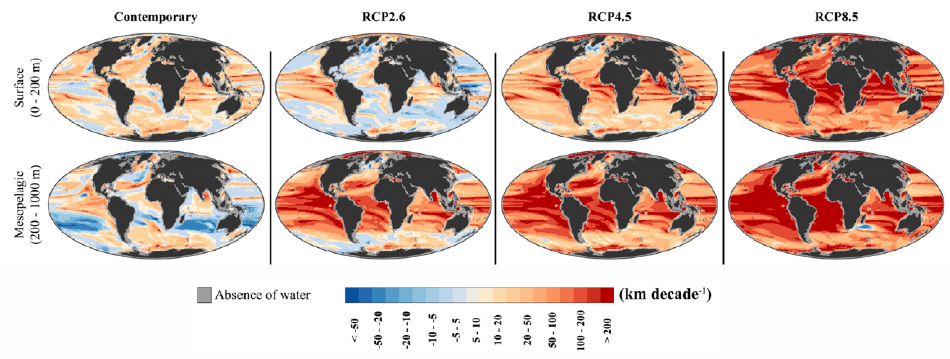May 26 2020
Although the ocean’s deeper layers are warming at a slower rate compared to the surface, animals that live in the deep ocean are highly subjected to climate warming and will experience rising challenges to retain their desired thermal habitats in the coming years.
 Climate velocity (km decade-1) for contemporary (1955-2005) and projected future sea temperatures (2050-2100) at sea surface and the mesopelagic layer under three IPCC greenhouse gas emission scenarios (RCP2.6, RCP4.5, and RCP8.5). Image Credit: Isaac Brito-Morales et al., Nature Climate Change. May 25th, 2020.
Climate velocity (km decade-1) for contemporary (1955-2005) and projected future sea temperatures (2050-2100) at sea surface and the mesopelagic layer under three IPCC greenhouse gas emission scenarios (RCP2.6, RCP4.5, and RCP8.5). Image Credit: Isaac Brito-Morales et al., Nature Climate Change. May 25th, 2020.
As reported in the Nature Climate Change journal, an international research group, under the guidance of the University of Queensland in Australia and including Hokkaido University, investigated current and future worldwide patterns of the speed at which climate change occurs throughout the depths of the ocean.
Their metric explains the temporary rate and direction of temperature changes, as a substitute for potential shifts of marine biota in reaction to climate change.
Although surface warming occurs very quickly, the researchers discovered that global mean climate velocities in the deepest layers of the ocean (>1,000 m) have been approximately 2 to 4-fold quicker compared to the surface over the second half of the 20th century.
According to the researchers, such larger velocities are due to the greater thermal homogeneity of the deep ocean environment. Furthermore, although climate velocities are expected to slow down under large-scale reduction of greenhouse gas emissions (RCP2.6), they will keep speeding up in the deep ocean.
Our results suggest that deep sea biodiversity is likely to be at greater risk because they are adapted to much more stable thermal environments. The acceleration of climate velocity for the deep ocean is consistent through all tested greenhouse gas concentration scenarios. This provides strong motivation to consider the future impacts of ocean warming to deep ocean biodiversity, which remains worryingly understudied.
Jorge García Molinos, Assistant Professor and Climate Ecologist, Arctic Research Center, Hokkaido University
By the end of the 21st century, in the mesopelagic layer of the ocean (200–1000 m), climate velocities are expected to be 4–11 times higher compared to the present velocities at the surface.
In the mesopelagic layer, marine life constitutes abundant amounts of small fish that become food for larger animals, such as squid and tuna. This could lead to further difficulties for commercial fisheries if predators and their prey deep down the water column do not obey the same range shifts.
Also, the researchers compared the ensuing spatial patterns of current climate velocity with that of marine biodiversity for more than 20,000 marine species to reveal potential regions of risk, where high velocity and biodiversity get overlapped.
While risk regions for surface and intermediate layers were found to be predominant in subtropical and tropical latitudes, those of the deepest layers are extensively distributed throughout all latitudes, apart from polar areas.
The researchers warn that while the ambiguity of the outcomes increases with depth, life in the deep ocean is also affected by several factors other than temperatures, such as light, oxygen concentrations, or pressure.
Without knowing if and how well deep ocean species can adapt to these changes, we recommend to follow a precautionary approach that limits the negative effects from other human activities such as deep-sea mining and fishing, as well as planning for climate-smart networks of large Marine Protected Areas for the deeper ocean.
Jorge García Molinos, Assistant Professor and Climate Ecologist, Arctic Research Center, Hokkaido University
Journal Reference:
Brito-Morales, I., et al. (2020) Climate velocity reveals increasing exposure of deep-ocean biodiversity to future warming. Nature Climate Change. doi.org/10.1038/s41558-020-0773-5.